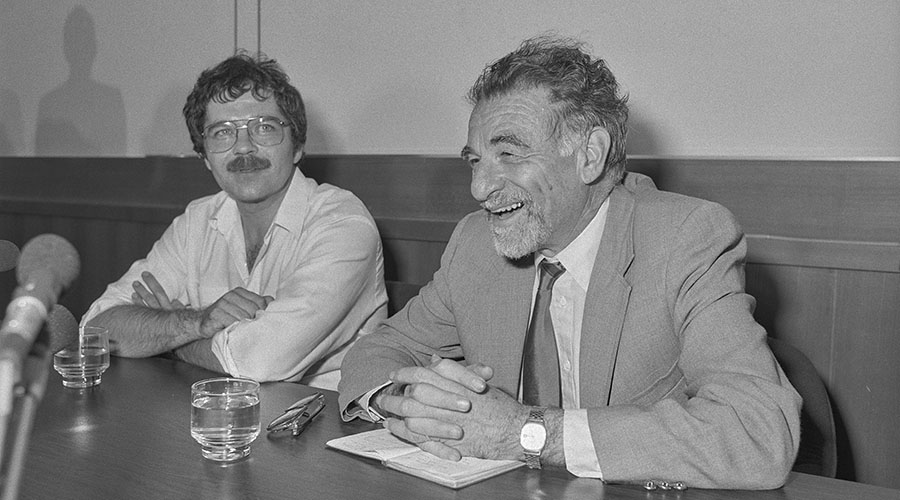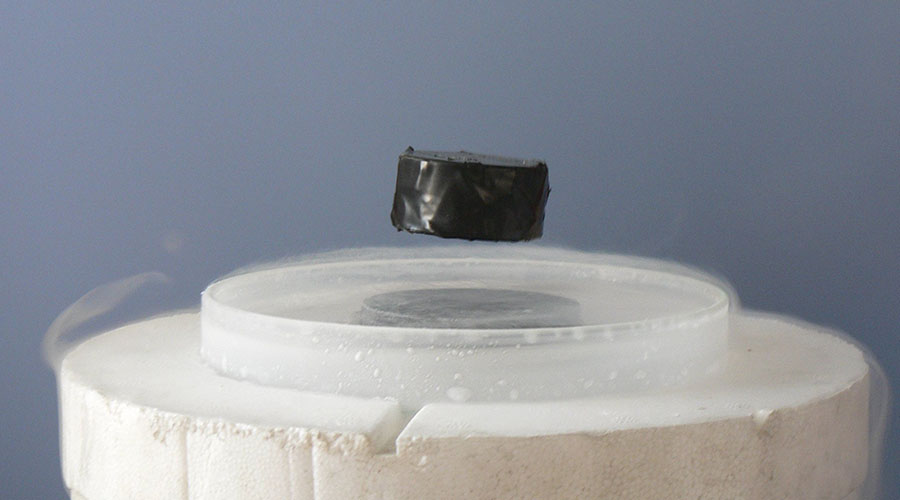April 1986: Bednorz and Müller Trigger Avalanche of High-Temperature Superconductivity Research
The duo’s work energized the 1987 APS meeting that became known as the “Woodstock of Physics.”
By Daniel Garisto | March 16, 2023

Credit: IBM Research Laboratory / Image Archive of the ETH Zürich Library.
J. Georg Bednorz (left) and K. Alexander Müller.
Nineteen months after J. Georg Bednorz and K. Alex Müller submitted their paper, “Possible high-Tc superconductivity in the Ba−La−Cu−O system,” to the journal Zeitschrift fur Physik B, they received a call from Stockholm — the shortest time ever from a discovery to a Nobel Prize in Physics. The avalanche of research on high temperature (high-Tc) superconductivity they triggered started slowly. Though the paper was published in June, it received no citations for the rest of 1986. In 1987, the paper was cited over 1,000 times.
Normally, even the best electrical conductor resists some of the electric current passing through it, causing energy loss. But superconductors, discovered in 1911, have zero resistance, promising unparalleled efficiency.
Prior to Bednorz and Müller’s discovery, however, superconductivity research had plateaued. Bardeen-Cooper-Schrieffer (BCS) theory, proposed in 1957, seemed to explain superconductivity adequately, and on the experimental side, the superconducting limit of 23.3 Kelvin (K) — around -249.9 °C or -417.7 °F — had not budged since 1973.
In the fall of 1983, Bednorz and Müller began searching for superconductivity outside traditional intermetallic compounds like niobium–tin. The idea to try metallic oxides came to Müller, as he recalled it, while “looking down on the ocean” (a great oxidizer) at a conference in Sicily. Research in the 1970s had already hinted at the potential of metal oxides like strontium titanate.
But Bednorz and Müller’s first efforts with metallic oxides fell short. Lanthanum nickel oxide was unimpressive, and replacing the lanthanum ion with an yttrium ion didn’t help. “We started wondering whether the target at which we were aiming really did exist,” Bednorz later recalled in his Nobel lecture.
Rescue came when they got better equipment and switched from nickel to copper. In late 1985, Bednorz and Müller began working with lanthanum barium copper oxide (LBCO). “It was earlier discovered by Raveau,” says Paul Chu, a high-Tc pioneer at the University of Houston. “But they only cooled it down to 77 Kelvin. I believe they were [some] of the most unhappy people on Earth at the time [of the Nobel].”
Finally, in February 1986, Bednorz and Müller observed a Tc of 35 K in LBCO. As Bednorz later told The New York Times, he celebrated with “one or two beers.”
A modest celebration made sense, as high-Tc superconductors had been plagued by false alarms. To check their results, Bednorz and Müller imaged the crystal structure of their samples with x-ray diffraction and confirmed that the resistivity dropped sharply, but were unable to perform a key test: observation of the Meissner-Ochsenfeld effect, where a superconductor expels a magnetic field. Nevertheless, they submitted the paper on April 17 and — given the uncertainty — had to persuade a Zeitschrift editor to accept the article.
In September, new equipment arrived, and they were able to take magnetic measurements that added to evidence that LBCO was a bonafide superconductor. Additionally, replacing lanthanum with strontium pushed the temperature to nearly 40 K.
A few groups were in hot pursuit to replicate Bednorz and Müller’s results: Shoji Tanaka’s group in Japan, Chu’s group, and a group at Bell Labs. “Not too many people paid any attention to it,” Chu says. “But when we saw it, we felt this is exactly what we're looking for.”

Credit: Mai-Linh Doan
A magnet levitating above a high-temperature superconductor, cooled with liquid nitrogen — an example of the Meissner effect.
Tanaka’s group got there first in late November, corroborating Bednorz and Müller’s results. In December, Chu and his colleagues confirmed LBCO was superconducting at 40 K — and could go higher, with added pressure. They saw fluctuations as high as 100 K, but nothing stable until they swapped lanthanum for yttrium.
When they submitted the paper to Physical Review Letters, it was initially rejected. “What they did is have a square rectangle that the secretary put on top of your abstract,” Chu explains. “If anything goes beyond that, it leads to automatic rejection.” Theirs had been an eighth of a line too long. Scrambling, Chu called Neil Ashcroft, then chair of the Division of Condensed Matter Physics.
Excited by the news of YBCO, Ashcroft swung into action and within a few hours, organized the legendary high-Tc session of the 1987 APS March Meeting.
Another discovery in January set the stage for what would be known as the “Woodstock of Physics.” On Jan. 29, 1987, colleagues of Chu at the University of Alabama in Huntsville synthesized yttrium barium copper oxide (YBCO). It superconducted at a balmy 92 K, warm enough that it could be cooled with just liquid nitrogen. “That really changed the world,” Chu says.
Videos and attendees’ recollections testify to an electric atmosphere. Bars near the New York City Hilton where the meeting was held opened to physicists, and camera flashes lit the faces of presenters. Müller, Tanaka, and Chu introduced the groundbreaking work to applause and a rapt audience. Speculation abounded about possible applications and higher Tcs, as physicists debated whether there was a new mechanism of superconductivity at work, beyond BCS theory.
“Within a few months, the field of superconductivity had experienced a tremendous revival,” Bednorz wrote in his Nobel lecture. “Nobody can predict where it will end.”
The excitement spread beyond physics. Paul Grant, a condensed matter physicist, and his daughter Heidi wrote a “Shake ‘n Bake” recipe for YBCO that could be synthesized in a pottery kiln:
Mix 1.13 grams yttrium oxide, 3.95 grams barium carbonate, 2.39 grams copper oxide
Compact
Grind in mortar and pestle
Bake in air at 950 ºC (1650 ºF)
Regrind in mortar and pestle
Press into pellets
Rebake pellets in flowing oxygen at 950 ºC (1650 ºF)
Allow to cool very slowly
By 1988, The New York Times reported that high school classrooms could buy a kit for $25 (about $63 today) with a superconducting pellet and magnet, cool it down with liquid nitrogen, and watch as the pellet of YBCO levitated above the magnet, thanks to the Meissner effect.
Earlier this year, on Jan. 9, Müller died at the age of 95. He never saw the revolution in technology many predicted during the heyday of high-Tc research. Instead, YBCO and other marvelous compounds proved unsuitable for commercial and industrial applications, and today remain mostly of interest to scientists — a reality Müller seemed at peace with.
“My best dreams are those where I am skiing downhill in good powder snow,” he explained in a 2015 oral history. “Whenever I have this dream, I am convinced that I am totally okay with respect to my physical conditions, my attitude to life, and my knowledge.”
Daniel Garisto is a writer based in New York.
Corrections: The original article misidentified the paper by Chu’s group that was initially rejected by Physical Review Letters. It was the December 1986 paper, not the February 1987 paper. The original article also misidentified the team that first synthesized superconducting YBCO. It was a team at the University of Alabama in Huntsville, not Chu’s team at the University of Houston.
©1995 - 2024, AMERICAN PHYSICAL SOCIETY
APS encourages the redistribution of the materials included in this newspaper provided that attribution to the source is noted and the materials are not truncated or changed.
Editor: Taryn MacKinney
April 2023 (Volume 32, Number 4)
Articles in this Issue

